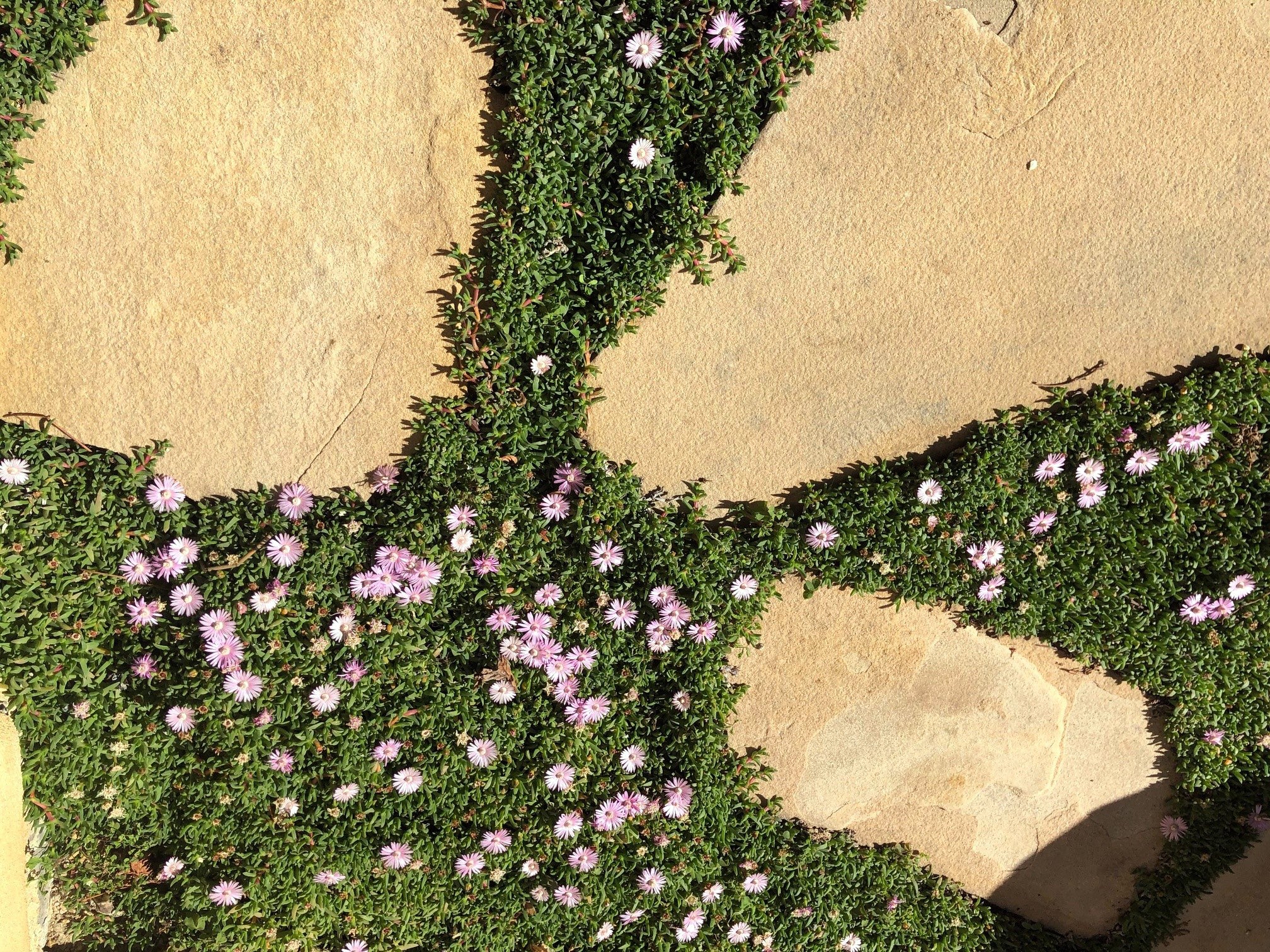
How to / Frequently Asked Questions
- Reference the FAQs below for quick answers.
- See the PDF link at the bottom of the page for more detailed explanations.
About Ruschia 'Nana'
Ruschia lineolata ‘Nana’ (PPAF) is a selection of the species, Ruschia lineolata, a low growing perennial groundcover from South Africa. Ruschia ‘Nana’ grows from 1-2” tall and is planted from plugs on a grid pattern. Ruschia ‘Nana’ has excellent heat tolerance, and reasonable cold tolerance, ranging from 20°F to 120°F.
When and Where to Plant
Ruschia ‘Nana’ may be planted year around, in areas of full sun to half sun (5-6 hours of sunlight minimum).

How long will it take to fill in?
Ruschia 'Nana' will fill in within 3-7 months, depending on planting time and spacing.
How many plugs do I need?
To determine plug needs, click the "Shop" tab above.

How do I prepare the site where I want to plant the plugs?
Ruschia ‘Nana’ tolerates a range of soil types, but will establish faster in soils that have had the top 4" loosened or tilled, and that have been amended with organic matter if needed, to improve soil texture.
When will I get my shipment?
We ship out on Tuesday's for Wednesday delivery but orders need to be received by the previous Friday.
What do I do when I get my shipment?
Immediately open boxes upon arrival. Place plugs in an open area in partial to full sun, preferably protected from wind. Avoid delaying plug planting by more than one week. Plug trays will need to be kept adequately watered during any holding period; this may be once or more a day in very hot weather if plugs are in full sun.
How do I plant my Ruschia 'Nana' plugs?
Planting Ruschia ‘Nana’ is simple. First, make sure site is properly prepared, and that plugs are well watered. Next, dig a hole twice as wide and the same depth as the plug. Place the plug in the hole and lightly pack loose soil around it, exposing foliage above soil level. IMPORTANT: Leave no air pockets! Plug soil not surrounded by landscape soil will dry out quickly and reduce chance of survival.
How often do I water Ruschia 'Nana'?
During grow-in period, water Ruschia 'Nana' plugs lightly and frequently from directly overhead to keep them moist, without washing away the soil around the plugs. Once established, Ruschia ‘Nana’ requires irrigation once every 8-10 days to hold green color during Summer, and less during other seasons.
Do I need to fertilize?
Ruschia ‘Nana’ has a low fertilizer requirement, but will benefit from a fertilization at the time of planting, and once a year in early spring with a balanced 15-15-15 fertilizer.
What about weeds?
Remove weeds in new plantings by hand; once established, Ruschia ‘Nana’ provides excellent weed suppression.
Do I need to worry about bugs?
Ruschia ‘Nana’ has no known diseases or pests.
What about Rabbits / Dogs / Bees?
RABBITS - Rabbits may damage new Ruschia 'Nana' plantings in the winter months, particularly when there is little other vegetation around. The damage does not kill the plugs but may set back the fill in time substantially,due to loss of growth. Where large populations are a concern and particularly in the winter months, we suggest providing temporary low fencing around the planting area. By late February / early March the rabbits will be more interested in softer textured vegetation.
DOGS - To date, Ruschia 'Nana' has held up quite well to dog wear in terms of physical play and urine. It is not totally urine-proof (not many plants are!), but it is pretty though, especially as compared with traditional grass lawns.
BEES - Ruschia ‘Nana’ flowers very little when young. When mature, it will bloom from January through March, and then lightly in late September/October. Bees will find the flowers attractive, but is not a heavy blooming plant as are many of the ice plants (Mesembryanthemum and Lampranthus species).
Do I have to trim or mow?
Ruschia 'Nana' does not require mowing.
What about mulching?
Mulching is not recommended for Ruschia ‘Nana’.
How much sun does Ruschia 'Nana' take?
Ruschia 'Nana' will do best in full sun, but tolerates a minimum of a half day of sunlight.
Is it durable?
Yes, once established Ruschia 'Nana' is extremely tough. Takes foot traffic, and needs minimal maintenance.
How does a Ruschia lawn cost compare to a traditional lawn?
You have to look at both short term and long term costs. See following estimates, and note that cost of demolition of an old lawn and prep work for the new planting area are not included in these figures:
Traditional lawn (e.g. ‘Marathon’, from sod):
Short term costs: Includes sod cost of $1.20 per sf, plus sales tax, plus your time to pick up and transport home, plus your time to plant and establish.
Long term costs: Includes weekly mowing, edging, weeding/herbicides, fertilization 2-3 times/year; factor in your time. - If using a mowing service, add est. $ 30.00 per week, or $ 1,560.00 per year. Add water cost (varies by district); estimated water needs for a tall fescue lawn such as ‘Marathon’ ranges between 40 - 55” of water, annually.
Ruschia lawn:
Short term costs: Includes plugs at cost of $2.22 per sf, planted at 9” on center, plus sales tax, plus delivery to your door (est. $ 0.15 per plug), plus your time to plant and establish.
Long Term costs: No mowing required; edging perhaps once every 2-3 months; fertilization 1x per year; weeding rare once established/no herbicides needed; factor in your time. - No mowing service required. Add water cost (varies by district); estimated water needs for Ruschia ‘Nana’ is 10-12” of water, annually.
Downloadable PDF link
FOR A PRINTABLE PDF OF DETAILED 'INSTALLATION & CARE GUIDELINES' CLICK HERE

